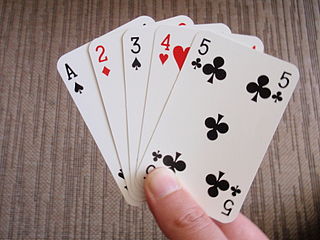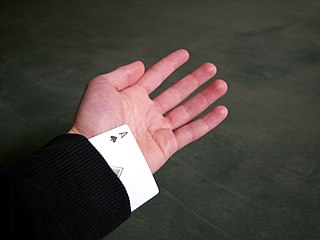In card games, a burn card is a playing card dealt from the top of a deck, and discarded ("burned"), unused by the players. Burn cards are usually not shown to the players.

Blackjack is a casino banking game. It is the most widely played casino banking game in the world. It uses decks of 52 cards and descends from a global family of casino banking games known as "twenty-one". This family of card games also includes the European games vingt-et-un and pontoon, and the Russian game Ochko. The game is a comparing card game where players compete against the dealer, rather than each other.

A playing card is a piece of specially prepared card stock, heavy paper, thin cardboard, plastic-coated paper, cotton-paper blend, or thin plastic that is marked with distinguishing motifs. Often the front (face) and back of each card has a finish to make handling easier. They are most commonly used for playing card games, and are also used in magic tricks, cardistry, card throwing, and card houses; cards may also be collected. Playing cards are typically palm-sized for convenient handling, and usually are sold together in a set as a deck of cards or pack of cards.

Shuffling is a procedure used to randomize a deck of playing cards to provide an element of chance in card games. Shuffling is often followed by a cut, to help ensure that the shuffler has not manipulated the outcome.

Cheating in poker is any behavior outside the rules of poker that is intended to give an unfair advantage to one or more players.

Faro, Pharaoh, Pharao, or Farobank is a late 17th-century French gambling game using cards. It is descended from Basset, and belongs to the Lansquenet and Monte Bank family of games due to the use of a banker and several players. Winning or losing occurs when cards turned up by the banker match those already exposed.

Card counting is a blackjack strategy used to determine whether the player or the dealer has an advantage on the next hand. Card counters try to overcome the casino house edge by keeping a running count of high and low valued cards dealt. They generally bet more when they have an advantage and less when the dealer has an advantage. They also change playing decisions based on the composition of the deck and sometimes play in teams.

Cheat is a card game where the players aim to get rid of all of their cards. It is a game of deception, with cards being played face-down and players being permitted to lie about the cards they have played. A challenge is usually made by players calling out the name of the game, and the loser of a challenge has to pick up every card played so far. Cheat is classed as a party game. As with many card games, cheat has an oral tradition and so people are taught the game under different names.

Card manipulation, commonly known as card magic, is the branch of magic that deals with creating effects using sleight of hand techniques involving playing cards. Card manipulation is often used in magical performances, especially in close-up, parlor, and street magic. Some of the most recognized names in this field include Dai Vernon, Tony Slydini, Ed Marlo, S.W. Erdnase, Richard Turner, John Scarne, Ricky Jay and René Lavand. Before becoming world-famous for his escapes, Houdini billed himself as "The King of Cards". Among the more well-known card tricks relying on card manipulation are Ambitious Card, and Three-card Monte, a common street hustle also known as Find the Lady.
Second dealing is a method of manipulating a deck of cards during a card game by way of dealing the second, rather than the top card of the deck, usually for the purpose of cheating. Second dealing and bottom dealing are also used in performance magic.
A trick deck is a deck of playing cards that has been altered in some way to allow magicians to perform certain card tricks where sleight of hand would be too difficult or impractical.

John Scarne was an American magician and author who was particularly adept at playing card manipulation. He became known as an expert on cards and other games, and authored a number of popular books on cards, gambling, and related topics.
Cheating in casinos refers to actions by the player or the house which are prohibited by regional gambling control authorities. This may involve using suspect apparatus, interfering with apparatus, chip fraud or misrepresenting games. The formally prescribed sanctions for cheating depend on the circumstances and gravity of the cheating and the jurisdiction in which the casino operates. In Nevada, for a player to cheat in a casino is a felony under state law. In most other jurisdictions, specific statutes do not exist, and alleged instances of cheating are resolved by the gambling authority who may have more or less authority to enforce its verdict.
Onslaught is a Magic: The Gathering expert-level block. It consists of the expansion sets Onslaught, Legions and Scourge. The block's main theme is creature types, and much of the game play concerns interactions between these "tribes". The story continues the saga of the Mirari from the previous block of expansion sets. Onslaught was the last block printed before the "modern" card face style was introduced.
Gameplay of the collectible card game Magic: The Gathering is fueled by each player's deck of cards, which constitute the resources that player can call upon to battle their opponents in any given game. With more than 20,000 unique cards in the game, a considerable number of different decks can be constructed. Each card is designed to have certain strengths and therefore a significant part of the game is determined by which cards a player chooses to include in their deck. Broadly speaking, decks can be loosely classified based on their play style and mode of victory. The game's designers often explicitly create cards which are intended to fuel one or more of these given archetypes, in order to create competitive balance and diversity.
This is a glossary of conjuring terms used by magicians.

A poker dealer distributes cards to players and manages the action at a poker table.

Shade is a 2003 American neo-noir crime thriller film directed and written by Damian Nieman and starring Stuart Townsend, Gabriel Byrne, Thandiwe Newton, Jamie Foxx, Melanie Griffith and Sylvester Stallone. The film follows a trio of grifters who attempt to set up a legendary card shark nicknamed "the Dean". The film had a limited release in the United States on May 7, 2004.
Card advantage is a term used in collectible card game strategy to describe the state of one player having access to more cards than another player, usually by drawing more cards through in-game effects to increase the size of their hand. Although it applies to several collectible card games, the concept was first described early in the evolution of Magic: The Gathering strategy, where many early decks relied on a player drawing more cards than their opponent, and then using this advantage to play more cards and advance their position faster than their opponent. By 2007 it was recognized as one of the most important indicators of who is ahead in a game and has been utilized in the development of strategy for nearly every collectible card game created.

Edge sorting is a technique used in advantage gambling where a player determines whether a face-down playing card is likely to be low or high at casino table games by observing, learning, and exploiting subtle unintentional differences on the backs of the cards being dealt. The technique requires the player to trick the dealer into rotating specific, high-value cards so that they are distinguishable from lower-value ones after shuffling.














